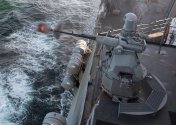The physics of interception are already known, regardless of the missile we're talking about, be it LRASM or Storm Shadow.LRASM is very similiar to those Storm Shadow missiles that UK sent to Ukraine. It has some success against Russia and I also heard reports that several of them had been shot down.
I guess if you launch a swarm of missiles, anything can penetrate the defense.
There are fire directors equipped with EO (TV, IIR) systems for both cannons and point defense missiles, but the warning is still 99.99% carried out by surveillance radars, even in the case of the Phalanx, for example.
What if they achieved such a level of stealth that the missile is literally "invisible" to X- and K-band radars, which are generally the ones that warn of approaching sea-skimming threats?
There are already ships equipped with IRST-based surveillance systems, but they can be counted on the fingers of one hand. And yet, I have no doubt that this missile has a very reduced IR signature, making even this mode of observation difficult.
One question that arises is: why does a stealth missile have to be sea-skimming? Basically, what we see is that for scanning the horizon at low altitudes, X- and K-band radars (and at most C-band) are ideal. These are the bands in which stealth technology is particularly effective. Long-range surveillance radars in S- and L-bands are not effective for contact very close to the sea surface and are the bands in which stealth begins to degrade. Thus, the LRASM retains the ability to fly close to sea level in the final phase to delay the alert of ships using long-range radars.
If detected earlier by these long-range radars, there would be enough time to turn the EO fire directors against the threats, and this is what the low altitude of the missiles in the final phase aims to prevent.
It is worth noting that they must have some level of ECM. The fact that the missile has a low radar signature and is close to the radar emitters allows compact, low-power jammers to have the potential to degrade the performance of the fire direction radars. And of course, the old saturation attack tactic will certainly continue, given the point defense level of some ships.
This is the solution the Americans have developed, and it doesn't mean it's a miracle or that it will always work. However, it is an important advance that, combined with other advances, such as the use of the SM-6 anti-ship missile, will eliminate or at least significantly reduce the US's lag behind Russian and Chinese anti-ship missile technology.

